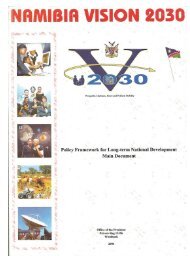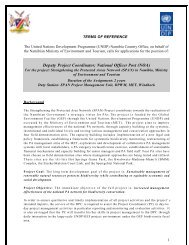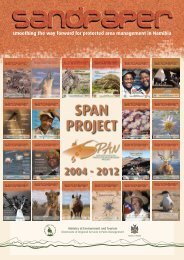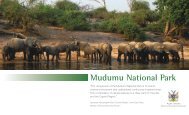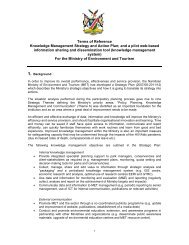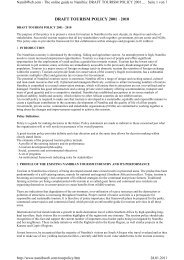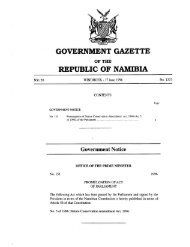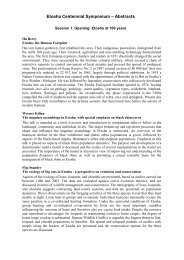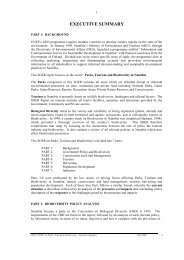HWCM - Ministry of Environment and Tourism
HWCM - Ministry of Environment and Tourism
HWCM - Ministry of Environment and Tourism
Create successful ePaper yourself
Turn your PDF publications into a flip-book with our unique Google optimized e-Paper software.
National Workshop on Human Wildlife Conflict Management 2005<br />
8 Modification <strong>of</strong> l<strong>and</strong> use to create or secure elephant movement routes.<br />
Lessons learned<br />
8 Can be encouraged, implemented, monitored <strong>and</strong> evaluated entirely at the local level<br />
through dialogue <strong>and</strong> consultation;<br />
8 But only possible in a policy environment with some legitimate, enabled form <strong>of</strong> local<br />
participation in wildlife management.<br />
10. Building on positive relationships between people <strong>and</strong> elephants<br />
8 Coexistence <strong>of</strong> people <strong>and</strong> elephants in pastoralist societies;<br />
8 Beliefs that elephants are humans <strong>and</strong> associated taboos concerning the killing <strong>of</strong><br />
elephants;<br />
8 Elephants considered as symbols <strong>of</strong> good luck in some societies (e.g. in Mali);<br />
8 Direction <strong>of</strong> elephant movements a portent <strong>of</strong> particular events.<br />
Lessons learned<br />
8 We still know surprisingly little about the human dimension <strong>of</strong> HEC – local attitudes <strong>and</strong><br />
perceptions are central to the issue;<br />
8 Working within local belief systems leads to increased tolerance towards elephants,<br />
thereby reducing HEC;<br />
8 May only be site or society-specific solutions.<br />
11. Conflict Resolution Committees - sharing responsibility for managing HEC<br />
8 Local committees comprised <strong>of</strong> affected communities, relevant CBOs, NGOs, wildlife<br />
authorities <strong>and</strong> private sector, etc. who share responsibility for dealing with HEC;<br />
8 Used successfully in Ghana, Guinea <strong>and</strong> Kenya.<br />
Lessons learned<br />
8 Devolving responsibility to different local stakeholders helps to combat HEC more<br />
effectively;<br />
8 More sustainable in the long-term than relying on local wildlife authority to “take care <strong>of</strong><br />
the problem”.<br />
Common fallacies<br />
8 “One size fits all”;<br />
8 The intensity <strong>of</strong> HEC is directly proportional to the size <strong>of</strong> the elephant population;<br />
8 Elephants can be easily “trained” to be deterred from crop raiding;<br />
8 The rogue elephant theory;<br />
8 HEC is the government’s problem <strong>and</strong> can be dealt with effectively by PAC measures<br />
alone;<br />
8 Elephants are the most serious pest species.<br />
So, what can we conclude<br />
8 Coexistence <strong>of</strong> people <strong>and</strong> elephants in pastoralist societies;<br />
8 Beliefs that elephants are humans <strong>and</strong> associated taboos concerning the killing <strong>of</strong><br />
elephants;<br />
8 Elephants considered as symbols <strong>of</strong> good luck in some societies (e.g. in Mali);<br />
8 Direction <strong>of</strong> elephant movements a portent <strong>of</strong> particular events.<br />
AfESG’s HEC tools <strong>and</strong> products:<br />
8 Numerous technical briefs <strong>and</strong> case studies available in French, English <strong>and</strong><br />
Portuguese on AfESG website: www.iucn.org/afesg<br />
8 African Elephant Library has a sub-set 50 <strong>of</strong> 4,700 abstracted references:<br />
www.elephant.chebucto.ns.ca



